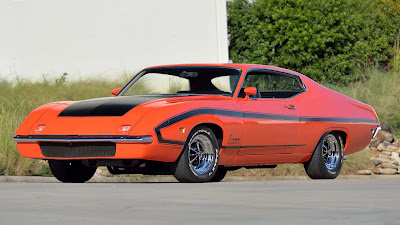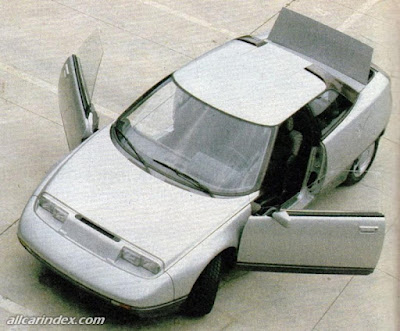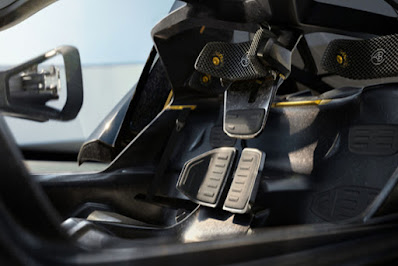Art of Speed - The allure of classic cars is undeniable, capturing the hearts of many with their timeless elegance and unique design. These vehicles are more than just modes of transportation; they are rolling pieces of art, each with a story and a soul that reflects a bygone era. The scarcity of these automobiles only adds to their mystique, making them highly coveted by enthusiasts who are often willing to spend large sums to own a piece of automotive history. Some are so passionate about these classic designs that they go a step further, creating limited-edition reproductions that pay homage to the original masterpieces.
 |
| The Dowsetts Comet's design is a tribute to the sports cars and racers of the 1950s and 1960s. (Picture from: Carscoops) |
The 1960s are often regarded as the golden age of automotive design. This decade gave birth to some of the most iconic vehicles ever made, such as the Ferrari 250 GTO, the Jaguar E-Type, and the Lamborghini Miura, among others. These cars set the standard for beauty and performance, leaving a lasting impact on the automotive world. Many enthusiasts believe that the design language and driving experience of this era represent the pinnacle of automotive engineering.
 |
| The Dowsetts Comet, created by Ant Anstead’s company, embodies the spirit of classic sports cars while delivering modern performance.. (Picture from: Carscoops) |
Ant Anstead, a well-known engineer and television personality, shares this belief. His passion for classic cars led him to establish the Dowsetts Classic Car Company. Anstead’s company aimed to capture the essence of 1960s automotive design, combining it with modern technology to create something truly special. This vision culminated in the creation of the Dowsetts Comet, a car that embodies the spirit of classic sports cars while offering the performance of a modern machine.
 |
| The Dowsetts Comet's bodywork is made from Kevlar-reinforced fiberglass, a material chosen for its strength and lightness. (Picture from: Carscoops) |
The Dowsetts Comet is a rare gem in the automotive world, with only a handful of units ever produced. These cars are built in a small factory in the English countryside, where each vehicle is meticulously crafted by hand. Despite their English origins, the Comets are powered by American V8 engines, ensuring that they deliver exhilarating performance. The combination of classic design and modern power makes the Comet a unique and desirable vehicle.
 |
| The Dowsetts Comet's cabin fuses classic charm with modern touches, featuring red quilted leather reminiscent of luxurious 1960s sports cars. (Picture from: Carscoops) |
The Comet's design is a tribute to the sports cars and racers of the 1950s and 1960s. Its body is made from Kevlar-reinforced fiberglass, a material chosen for its strength and lightness. The design is both elegant and aggressive, with lines that harken back to the golden age of motorsports. The car is finished in Porsche Crayon Grey, a color that enhances its vintage appeal.
 |
| The Dowsetts Comet powered by a 6.2-liter GM LS3 V8 engine, paired with a Tremec 5-speed transmission. (Picture from: Carscoops) |
Underneath its striking exterior, the Comet is built on a steel spaceframe chassis, providing a solid foundation for the car's performance. Independent suspension and disc brakes at each corner ensure that the Comet handles as well as it looks. The car rides on bespoke wheels designed specifically for the Dowsetts Comet, further emphasizing its exclusivity.
The heart of the Comet is a 6.2-liter GM LS3 V8 engine, paired with a Tremec 5-speed transmission. This powertrain is a nod to the muscle cars of the past, offering raw, unfiltered power. With 430 horsepower on tap, the Comet can accelerate from 0 to 60 mph in just 3.9 seconds, making it as fast as many modern sports cars.
 |
| Underneath its striking exterior, the Dowsetts Comet is built on a steel spaceframe chassis, providing a solid foundation for the car's performance. (Picture from: Carscoops) |
Inside, the Comet's cabin is a blend of classic and modern elements. The interior is upholstered in red quilted leather, reminiscent of the luxurious sports cars of the 1960s. The dashboard features white-faced dials, a Moto-Lita steering wheel, and a turned aluminum gear stick, all of which contribute to the car's vintage charm. However, the Comet is not purely a throwback; it includes modern conveniences such as air conditioning, satellite navigation, and a reversing camera, making it a practical choice for long drives.
 |
| The Dowsetts Comet is more than just a car; it’s a tribute to a golden era of automotive design. (Picture from: Carscoops) |
One of the most intriguing aspects of the Dowsetts Comet is its exclusivity. The first chassis, known as #001, caught the attention of a particular car enthusiast who then commissioned the second chassis, #002. This individual specified that the car be tailored for grand touring, with a focus on comfort and style. Unfortunately, after only 2,500 miles, the owner suffered a back injury that prevented him from enjoying the car. This led to the sale of the vehicle at the NEC Classic Motor Show Sale in 2021, where it fetched a price of £65,250.
 The Dowsetts Comet is more than just a car; it’s a tribute to a golden era of automotive design. It embodies the passion and dedication of those who strive to preserve the beauty and spirit of classic sports cars while seamlessly integrating modern engineering. Each Comet is a unique creation, a rare work of art that captures the essence of the 1960s, paired with the performance and reliability of a contemporary vehicle. For those fortunate enough to own one, the Comet is not just a car but a symbol of an era that continues to inspire automotive enthusiasts worldwide. Additionally, Ant Anstead’s legacy extends to the creation of the Radford Type 62-2 racing car. *** [EKA | FROM VARIOUS SOURCES | DOWSETTSCARS | CARSCOOPS | SILODROME | ICONICAUCTIONEERS | CARANDCLASSIC | CARSONLINE.BONHAM ]
The Dowsetts Comet is more than just a car; it’s a tribute to a golden era of automotive design. It embodies the passion and dedication of those who strive to preserve the beauty and spirit of classic sports cars while seamlessly integrating modern engineering. Each Comet is a unique creation, a rare work of art that captures the essence of the 1960s, paired with the performance and reliability of a contemporary vehicle. For those fortunate enough to own one, the Comet is not just a car but a symbol of an era that continues to inspire automotive enthusiasts worldwide. Additionally, Ant Anstead’s legacy extends to the creation of the Radford Type 62-2 racing car. *** [EKA | FROM VARIOUS SOURCES | DOWSETTSCARS | CARSCOOPS | SILODROME | ICONICAUCTIONEERS | CARANDCLASSIC | CARSONLINE.BONHAM ]Note: This blog can be accessed via your smart phone
































